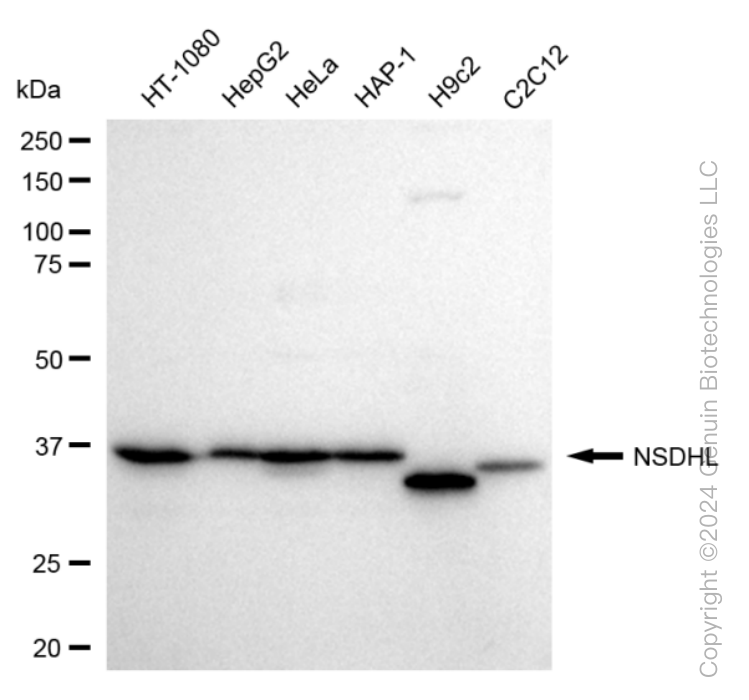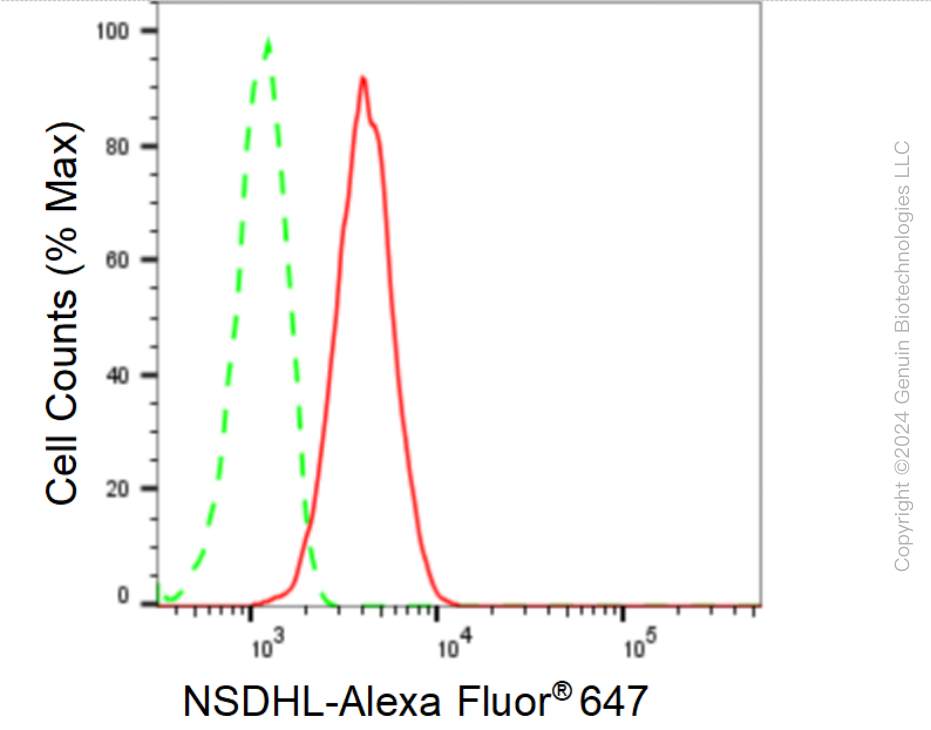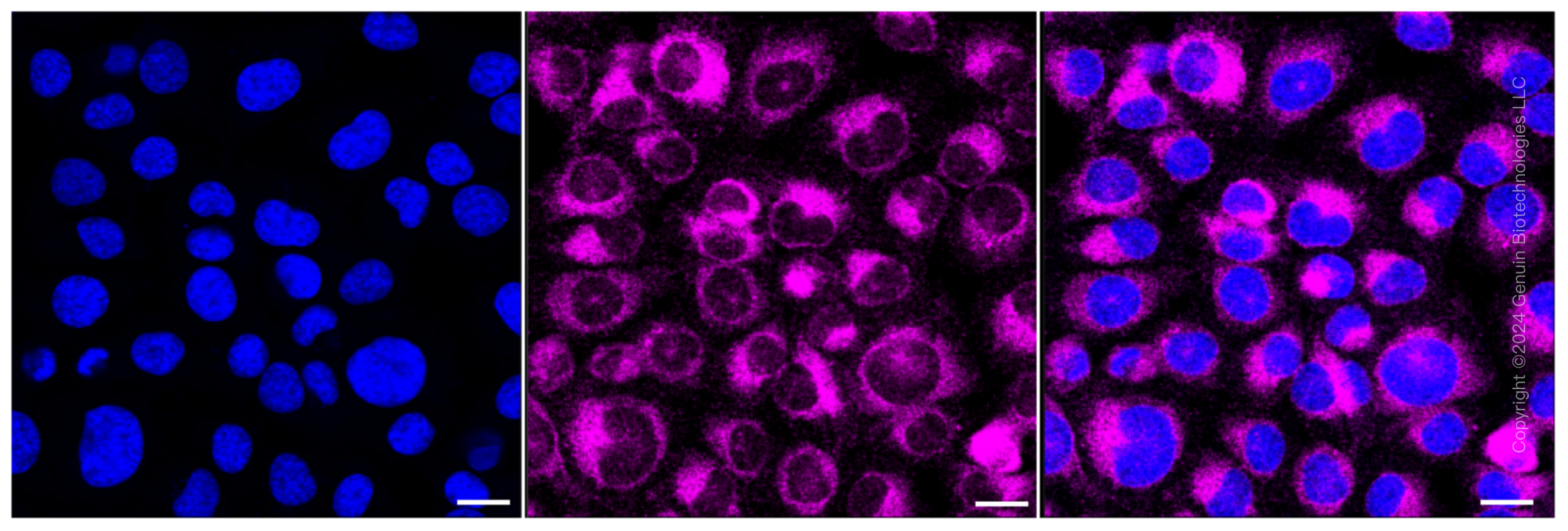KD-Validated Anti-NSDHL Rabbit Monoclonal Antibody
Rabbit monoclonal antibody
- SPECIFICATION
- CITATIONS
- PROTOCOLS
- BACKGROUND

Application
| WB, FC, ICC |
|---|---|
| Primary Accession | Q15738 |
| Reactivity | Rat, Human, Mouse |
| Clonality | Monoclonal |
| Isotype | Rabbit IgG |
| Clone Names | 24GB510 |
| Calculated MW | Predicted, 42 kDa , observed , 38 kDa |
| Gene Name | NSDHL |
| Aliases | NAD(P) Dependent Steroid Dehydrogenase-Like; SDR31E1; XAP104; H105e3; Sterol-4-Alpha-Carboxylate 3-Dehydrogenase, Decarboxylating; Short Chain Dehydrogenase/Reductase Family 31E, Member 1; Protein H105e3; EC 1.1.1.170; NAD(P) Dependent Steroid Dehydrogenase-Like Protein Transcript; Epididymis Secretory Sperm Binding Protein; H105E3 |
| Immunogen | A synthesized peptide derived from human NSDHL |
| Gene ID | 50814 |
|---|---|
| Other Names | Sterol-4-alpha-carboxylate 3-dehydrogenase, decarboxylating, 1.1.1.170, Protein H105e3, NSDHL, H105E3 |
| Name | NSDHL |
|---|---|
| Synonyms | H105E3 |
| Function | Catalyzes the NAD(P)(+)-dependent oxidative decarboxylation of the C4 methyl groups of 4-alpha-carboxysterols in post-squalene cholesterol biosynthesis (By similarity). Also plays a role in the regulation of the endocytic trafficking of EGFR (By similarity). |
| Cellular Location | Endoplasmic reticulum membrane; Single-pass membrane protein. Lipid droplet {ECO:0000250|UniProtKB:Q9R1J0} Note=Trafficking through the Golgi is necessary for ER membrane localization. {ECO:0000250|UniProtKB:Q9R1J0} |
| Tissue Location | Brain, heart, liver, lung, kidney, skin and placenta |

Thousands of laboratories across the world have published research that depended on the performance of antibodies from Abcepta to advance their research. Check out links to articles that cite our products in major peer-reviewed journals, organized by research category.
info@abcepta.com, and receive a free "I Love Antibodies" mug.
Provided below are standard protocols that you may find useful for product applications.
If you have used an Abcepta product and would like to share how it has performed, please click on the "Submit Review" button and provide the requested information. Our staff will examine and post your review and contact you if needed.
If you have any additional inquiries please email technical services at tech@abcepta.com.














 Foundational characteristics of cancer include proliferation, angiogenesis, migration, evasion of apoptosis, and cellular immortality. Find key markers for these cellular processes and antibodies to detect them.
Foundational characteristics of cancer include proliferation, angiogenesis, migration, evasion of apoptosis, and cellular immortality. Find key markers for these cellular processes and antibodies to detect them. The SUMOplot™ Analysis Program predicts and scores sumoylation sites in your protein. SUMOylation is a post-translational modification involved in various cellular processes, such as nuclear-cytosolic transport, transcriptional regulation, apoptosis, protein stability, response to stress, and progression through the cell cycle.
The SUMOplot™ Analysis Program predicts and scores sumoylation sites in your protein. SUMOylation is a post-translational modification involved in various cellular processes, such as nuclear-cytosolic transport, transcriptional regulation, apoptosis, protein stability, response to stress, and progression through the cell cycle. The Autophagy Receptor Motif Plotter predicts and scores autophagy receptor binding sites in your protein. Identifying proteins connected to this pathway is critical to understanding the role of autophagy in physiological as well as pathological processes such as development, differentiation, neurodegenerative diseases, stress, infection, and cancer.
The Autophagy Receptor Motif Plotter predicts and scores autophagy receptor binding sites in your protein. Identifying proteins connected to this pathway is critical to understanding the role of autophagy in physiological as well as pathological processes such as development, differentiation, neurodegenerative diseases, stress, infection, and cancer.





